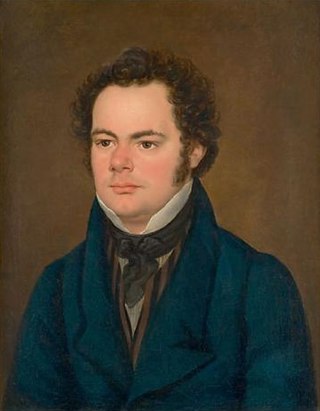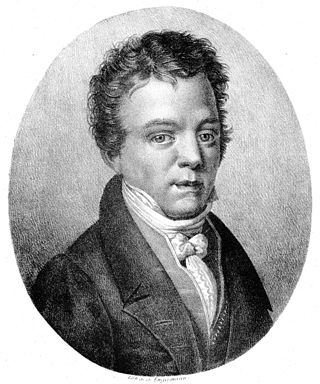Related Research Articles

Franz Peter Schubert was an Austrian composer of the late Classical and early Romantic eras. Despite his short life, Schubert left behind a vast oeuvre, including more than 600 secular vocal works, seven complete symphonies, sacred music, operas, incidental music, and a large body of piano and chamber music. His major works include the art songs Erlkönig, Gretchen am Spinnrade, Ave Maria; the Trout Quintet, the unfinished Symphony No. 8 in B minor, the "Great" Symphony No. 9 in C major, the String Quartet No. 14 "Death and the Maiden", a String Quintet, the two sets of Impromptus for solo piano, the three last piano sonatas, the Fantasia in F minor for piano four hands, the opera Fierrabras, the incidental music to the play Rosamunde, and the song cycles Die schöne Müllerin, Winterreise, and Schwanengesang.
This is a list of music-related events in 1818.
The Piano Quintet in F minor, Op. 34, by Johannes Brahms was completed during the summer of 1864 and published in 1865. It was dedicated to Her Royal Highness Princess Anna of Hesse. As with most piano quintets composed after Robert Schumann's Piano Quintet (1842), it is written for piano and string quartet.
An unfinished symphony is a fragment of a symphony, by a particular composer, that musicians and academics consider incomplete or unfinished for various reasons. The archetypal unfinished symphony is Franz Schubert's Symphony No. 8, written in 1822, six years before his death. It features two fully orchestrated movements. While it seems clear from sketches that Schubert set out to create a traditional four-movement symphony, this has been the subject of endless debate. Schubert wrote the symphony for the Graz Musical Society, and gave the manuscript to his friend Anselm Hüttenbrenner, in his capacity as its representative. However, Hüttenbrenner did not show the score to the society at that time, nor did he reveal the existence of the manuscript after Schubert died in 1828, but kept it a secret for another 37 years. In 1865, when he was 76, Hüttenbrenner finally showed it to the conductor Johann von Herbeck, who conducted the extant two movements on 17 December 1865 in Vienna, adding the last movement of Schubert's third symphony as the finale. Music historians and scholars then toiled to "prove" the composition was complete in its two-movement form, and indeed, in that form it became one of the most popular pieces in the late 19th century classical music repertoire, and remains one of Schubert's most popular compositions.

Joseph Johann Baptist Woelfl was an Austrian pianist and composer.

Franz Schubert's final chamber work, the String Quintet in C major is sometimes called the "Cello Quintet" because it is scored for a standard string quartet plus an extra cello instead of the extra viola which is more usual in conventional string quintets. It was composed in 1828 and completed just two months before the composer's death. The first public performance of the piece did not occur until 1850, and publication occurred three years later in 1853. Schubert's only full-fledged string quintet, it has been praised as "sublime" or "extraordinary" and as possessing "bottomless pathos," and is generally regarded as Schubert's finest chamber work as well as one of the greatest compositions in all chamber music.

The String Quartet No. 13 in A minor, D 804, Op. 29, was written by Franz Schubert between February and March 1824. It dates roughly to the same time as his monumental Death and the Maiden Quartet, emerging around three years after his previous attempt to write for the string quartet genre, the Quartettsatz, D 703, that he never finished.

Jan Václav Hugo Voříšek was a Czech composer, pianist, and organist.
Karl Ulrich Schnabel was an Austrian pianist. Schnabel was the son of pianist Artur Schnabel and operatic contralto and lieder singer Therese Behr and elder brother of the American actor Stefan Schnabel. An internationally celebrated teacher of the piano, his students include, among others, Leon Fleisher, Claude Frank, Richard Goode, Kwong-Kwong Ma, Stanislav Ioudenitch, Jon Nakamatsu, Murray Perahia, and Peter Serkin.

Franz Schubert wrote his Sonata in C major for piano four-hands, D 812, in June 1824 during his second stay at the Esterházy estate in Zseliz. The extended work, in four movements, has a performance time of around 40 to 45 minutes. It was published as Grand Duo, Op. 140, in 1837, nine years after the composer's death.
The Piano Sonata in G major D. 894, Op. 78 by Franz Schubert is a sonata for solo piano, completed in October 1826. The work is sometimes called the "Fantasie", a title which the publisher Tobias Haslinger, rather than Schubert, gave to the first movement of the work. It was the last of Schubert's sonatas published during his lifetime, and was later described by Robert Schumann as the "most perfect in form and conception" of any of Schubert's sonatas. A typical performance runs approximately 35 minutes.
Franz Schubert's Piano Sonata in C major, D. 840, nicknamed "Reliquie" upon its first publication in 1861 in the mistaken belief that it had been Schubert's last work, was written in April 1825, whilst the composer was also working on the A minor sonata, D. 845 in tandem. Schubert abandoned the C major sonata, and only the first two movements were fully completed, with the trio section of the third movement also written in full. The minuet section of the third movement is incomplete and contains unusual harmonic changes, which suggests it was there Schubert had become disillusioned and abandoned the movement and later the sonata. The final fourth movement is also incomplete, ending abruptly after 272 measures.

Piano four hands is a type of piano duet involving two players playing the same piano simultaneously. A duet with the players playing separate instruments is generally referred to as a piano duo.
The Piano Sonata in B major D 575 by Franz Schubert is a sonata for solo piano, posthumously published as Op. 147 and given a dedication to Sigismond Thalberg by its publishers. Schubert composed the sonata in August 1817.

The Fantasia in F minor by Franz Schubert, D.940, for piano four hands, is one of Schubert's most important works for more than one pianist and one of his most important piano works altogether. He composed it in 1828, the last year of his life. A dedication to his former pupil Caroline Esterházy can only be found in the posthumous first edition, not in Schubert's autograph.
The Violin Sonata No. 4 in A major, Op. posth. 162, D 574, for violin and piano by Franz Schubert was composed in 1817. This sonata, composed one year after his first three violin sonatas, was a much more individual work, showing neither the influence of Mozart, as in these previous works, nor of Rossini, as in the contemporaneous 6th Symphony.
Sonatas, duos and fantasies by Franz Schubert include all works for solo piano by Franz Schubert, except separate dances. They also include a number of works for two players: piano four hands, or piano and a string instrument.
From March 1816 to August 1817, Franz Schubert composed four violin sonatas. All four were published after the composer's death: the first three, D 384, 385 and 408, as Sonatinas in 1836, and the last one, D 574, as Duo in 1851. Schubert composed two more pieces for violin and piano, in October 1826 and December 1827 respectively: a Rondo, D 895, which was published during the composer's lifetime (Op. 70), and a Fantasy, D 934, which was premiered in January 1828, less than a year before the composer's death.
In 1816, Franz Schubert composed his first three violin sonatas, D 384, 385 and 408. They were published after the composer's death as Sonatinas in 1836. These sonatas breathe an intimate atmosphere, requiring relatively little virtuoso bravura from their performers.
References
- Notes
- ↑ Newbould 1999 , p. 71
- ↑ Harrison 1986 , p. 2
- Sources
- Anderson, Keith (2012). Schubert: Piano Works for Four Hands Vol. 6 (CD). Naxos Records. 8.572699.
- Harrison, Max (1986). Schubert: Grand Duo & Sonata in B-flat (PDF) (CD). Hyperion Records. CDA66217.
- Newbould, Brian (1999). Schubert: The Music and the Man. University of California Press. ISBN 0-520-21957-0.